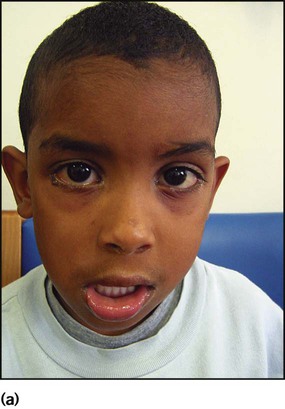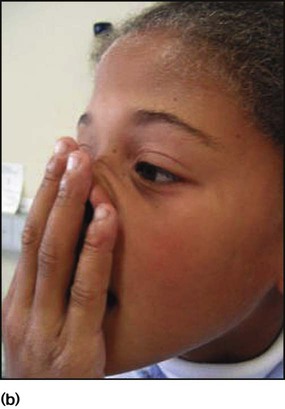An abnormal immune system may result in: • Autoimmune disorders – either organ specific (e.g. type I diabetes mellitus) or systemic (e.g. systemic lupus erythematosus). • In the UK up to 40% of children have allergic rhinitis, eczema or asthma and up to 6% develop food allergy • They are increasing in prevalence in many countries • They are the commonest chronic diseases of childhood and the commonest cause of school absence and acute hospital admissions • They cause significant morbidity and can be fatal, with about 20 children dying from asthma and 2 from food anaphylaxis in the UK each year. Explanations of some of the terms used in ‘allergy’ are listed in Box 15.1. Only a few stimuli account for most allergic disease: • Inhalant allergens, e.g. house-dust mite, plant pollens, pet dander and moulds in asthma and rhinitis and conjunctivitis • Ingestant allergens, e.g. nuts, seeds, legumes, cow’s milk, egg, seafood and fruits in acute allergic reactions or eczema • An early phase, occurring within minutes of exposure to the allergen, caused by release of histamine and other mediators from mast cells. Causes urticaria, angioedema, sneezing and bronchospasm • A late phase response may also occur after 4–6 hours. This causes nasal congestion in the upper airway, and cough and bronchospasm in the lower airway. The majority of severe life-threatening allergic reactions are IgE mediated. It is not clear why the prevalence of allergic diseases has increased in many countries and the speed of this change suggests an environmental cause. A consistent observation is that the risk is lower in younger children of large families and in children raised on farms. These findings have led to the hygiene hypothesis, which proposes that the increased prevalence is due to altered microbial exposure associated with modern living conditions (Fig. 15.1). Although the hypothesis remains the leading explanation for the increase in allergic disease, it is mainly supported by indirect evidence. Allergic children develop individual allergic disorders at different ages: • Eczema and food allergy usually develop in infancy; both are often present • Allergic rhinitis and conjunctivitis and asthma occur most often in preschool and primary school years • Rhinitis and conjunctivitis often precede the development of asthma, and in children with asthma, up to 80% have coexistent rhinitis. • Mouth breathing (Fig. 15.2a). Children who habitually breathe with their mouth open may have an obstructed nasal airway from rhinitis, and there may also be a history of snoring or obstructive sleep apnoea
Allergy
Paediatric allergy
Mechanisms of allergic disease
The hygiene hypothesis

The allergic march
Prevention of allergic diseases
History and examination
![]()
Stay updated, free articles. Join our Telegram channel

Full access? Get Clinical Tree




